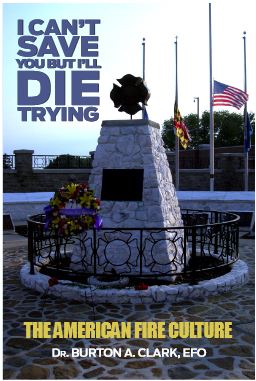Sponsored content by RESCUEINTELLITECH
By: Robert Avsec, Executive Fire Officer
Everyone seems to be talking and writing about the need for changes in the fire service culture for a variety of reasons. Somewhere right at the top of that list would be changing those elements of a fire department’s culture that can have a positive influence on reducing the risk of developing cancers from exposure to the toxic chemicals, chemical compounds, and carcinogens present in the smoke of structure fires today.

Before we go any further, it’s useful to have a common understanding of what culture is in any organization, including a fire department.
What are some of those “group norms of behavior and underlying shared values that help keep those norms in place?” What about these:
- Wearing dirty turnout gear, particularly the “beat up and battle-scarred” helmet, because those are the signs of a “real firefighter.”
- Failing to wear SCBA until completely out of the hazard area and then proceeding directly to initial contamination reduction, aka, gross decon, because it’s more important to “hang out” and socialize with fellow firefighters while everyone is still wearing their “battle gear.”
- Failing to handle turnout gear and other equipment used for fire suppression operations as hazardous waste until it’s been thoroughly cleaned and dried.
- Failing to change out of soiled uniforms or clothing and showering immediately upon return to the fire station.
But changing the fire service culture is not as easy as changing the type of hose that a department carries on its fire apparatus. That’s because making changes to the culture—that mix of rituals, values, and traditions that defines a group—is tricky business and frequently messy.
What is Fire Service Culture?
Dr. Burton Clark, author of the book, I Can’t Save You But I’ll Die Trying: The American Fire Culture, wrote that firefighter DNA is made up of genes that include:

- Fast – getting to the fire as quickly as possible.
- Wet – getting water on the fire as quickly as possible.
- Close – getting as close to the seat of the fire as possible when applying the water.
In a national study of the fire service safety climate, Situational Pressures that Influence Firefighters’ Decision Making about Personal Protective Equipment: A Qualitative Analysis (2016), Maglio and his colleagues conducted 62 interviews and 10 focus groups involving 123 firefighters from 12 fire departments. Those researchers learned that firefighter identity, goal seduction, and situation aversion were the strongest factors influencing PPE non-compliance by those firefighters interviewed.

a young princess was offered to the dragon; when George heard about this he rode into the village; and George slayed the dragon and rescued the princess
Even the newest recruit strongly identifies with the romantic notion that firefighters are some sort of modern-day version of St. George slaying dragons. Maglio and his team used the term firefighter identity to describe this cultural element (e.g., what it means be a “real” firefighter) as a far more powerful driver of firefighter behavior than that of acknowledged safety standards or departmental policy and procedures.
Maglio and his group defined goal seduction as a firefighter’s behavior when they are led to prioritize “getting there fast” over their own safety, such as, not taking time to don their PPE before boarding the apparatus or attempting to do so in the crew cab while the fire truck is moving (Clark’s “fast” gene).
Finally, a firefighter’s desire to be accepted in the group (e.g., their fire company) was cited by Maglio and his team as another powerful cultural element that leads firefighters to engage in situation aversion.
In situation aversion, a firefighter can be led away from making safe choices because those choices are inconvenient or uncomfortable, such as when choosing to be safe and wearing their PPE may invite ridicule and harassment from their peers.
The research team’s conclusions? It’s imperative that fire department leaders develop an understanding of those situations where PPE use by their personnel is both practiced and neglected if they are serious about improving the safety culture of their organization.
Peer-pressure and leading by example at both the peer and organizational levels appear to be essential considerations firefighters undertake when choosing whether or not they engage in the desired safety behavior.
Maglio, M., et al. Situational Pressures that Influence Firefighters’ Decision Making about Personal Protective Equipment: A Qualitative Analysis. American Journal of Health Behavior, Volume 40, Number 5, September 2016, pp. 555-567(13)
What Got You Here Won’t Get You There
During their research, Maglio’s team discovered two factors that heavily influence firefighter identity, goal seduction and situation aversion: individual will and organizational solidarity.
1. When an individual firefighter’s knowledge of occupational risk compels them to comply with PPE use, despite these other pressures, it’s because of their individual will. When fire department leaders regularly provide good training and education regarding acceptable safety practices and the potential risks associated with firefighting, they strengthen a firefighter’s individual will.
Why? Because when a firefighter understands the what, why and how regarding their PPE and its use, they are better prepared to resist negative pressure from others who choose not to comply. Simple, right?
2. They found that organizational solidarity was a powerful tool for showing that a firefighter’s leaders promote and embrace the organization’s safety policies. Leading by example never goes out of style.
Fire department leaders should always wear their PPE when they’re on the emergency scene. During their interviews, the research team learned that firefighters are more inclined to wear their PPE when their leaders set a personal example by wearing their own PPE.
Like most of us, you probably believe that we achieve progress or improvement through the spread of enlightened thinking: Give people the information, provide some training, and the problem is solved.
In the fire service culture, where we place so much emphasis on education and training for skills development, we’ve come to believe that we can change individual and group behaviors by appealing to the sense of right and wrong in our people (e.g., Who wouldn’t want to protect themselves from cancer?).
But if we really want to make meaningful and lasting improvements in the fire service culture, we may gain more ground by stopping our efforts at tapping into people’s desire to be good or virtuous. Rather, we should focus on something less lofty and, quite frankly, harder to admire: an individual’s powerful drive to fit in with the current and “accepted” cultural norms.
Read More: Firefighter decontamination challenges: Knowledge versus practice
 Fire & EMS Leader Pro The job of old firefighters is to teach young firefighters how to become old firefighters!
Fire & EMS Leader Pro The job of old firefighters is to teach young firefighters how to become old firefighters!